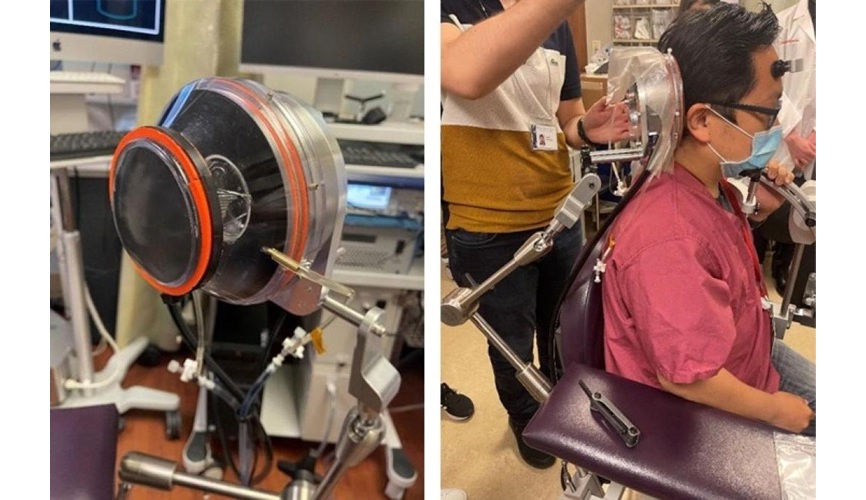Obesity Not a Deterrent to Total Joint Replacement Surgery
|
By HospiMedica International staff writers Posted on 01 Aug 2017 |
Obese patients who underwent knee or hip total joint replacement (TJR) reported similar post-operative pain relief and improved function as normal-weight patients, according to a new study.
Researchers at the Geisinger Health System (Danville, PA, USA), the University of Massachusetts Medical School (UMMS; Worcester, USA), and other institutions collected data from a U.S. national sample of 2,040 patients who underwent total hip replacement (THR) and 2,964 who underwent total knee replacement (TKR) from May 2011 to March 2013. Pre- and post-operative function and pain were evaluated according to body mass index (BMI) status, defined as under or of normal weight, overweight, obese, severely obese, or morbidly obese.
The results revealed that while severely and morbidly obese patients had less postoperative functional gain than the other BMI groups following THR, and with greater obesity level associated with more pain at baseline, they also experienced greater postoperative pain relief six months after surgery, so that the average postoperative pain scores did not differ significantly among BMI groups. Similar results were shown for patients undergoing TKR. The study was published on July 19, 2017, in the Journal of Bone and Joint Surgery.
“It's challenging for a patient who is severely overweight and suffering in pain to exercise; often they just can't do it. Our evidence showed that severe morbidly obese patients can benefit almost equally as normal weight patients in pain relief and gains in physical function,” said lead author Wenjun Li, PhD, of UMMS. “Patients who can lose weight should, but we acknowledge many people can't, or it will take a long time during which their joints will worsen. If they can get the surgery earlier, once function is restored they can better address obesity.”
“Losing weight by making appropriate dietary changes and increasing the calories burned each day through water exercise programs and other aerobic, non-weight bearing activities is always appropriate to decrease the risk of complications for overweight patients,” said study co-author David Ayers, MD, of UMMS. “The debate will continue in the morbidly obese patients with BMI over 40, and the super obese with a BMI over 50, regarding what steps can and should be taken to lower the risks before these elective surgical procedures.”
BMI is a value defined as the body mass divided by the square of the body height, and is universally expressed in units of kg/m2. It was developed as an attempt to quantify the amount of tissue mass (muscle, fat, and bone) in an individual, and then categorize that person as underweight, normal weight, overweight, or obese based on that value. However, there is some debate about where on the BMI scale the dividing lines between categories should be placed, and recent studies claim that other measures, such as waist-to-height ratio (WHtR) and body fat, are better predictors.
Related Links:
Geisinger Health System
University of Massachusetts Medical School
Researchers at the Geisinger Health System (Danville, PA, USA), the University of Massachusetts Medical School (UMMS; Worcester, USA), and other institutions collected data from a U.S. national sample of 2,040 patients who underwent total hip replacement (THR) and 2,964 who underwent total knee replacement (TKR) from May 2011 to March 2013. Pre- and post-operative function and pain were evaluated according to body mass index (BMI) status, defined as under or of normal weight, overweight, obese, severely obese, or morbidly obese.
The results revealed that while severely and morbidly obese patients had less postoperative functional gain than the other BMI groups following THR, and with greater obesity level associated with more pain at baseline, they also experienced greater postoperative pain relief six months after surgery, so that the average postoperative pain scores did not differ significantly among BMI groups. Similar results were shown for patients undergoing TKR. The study was published on July 19, 2017, in the Journal of Bone and Joint Surgery.
“It's challenging for a patient who is severely overweight and suffering in pain to exercise; often they just can't do it. Our evidence showed that severe morbidly obese patients can benefit almost equally as normal weight patients in pain relief and gains in physical function,” said lead author Wenjun Li, PhD, of UMMS. “Patients who can lose weight should, but we acknowledge many people can't, or it will take a long time during which their joints will worsen. If they can get the surgery earlier, once function is restored they can better address obesity.”
“Losing weight by making appropriate dietary changes and increasing the calories burned each day through water exercise programs and other aerobic, non-weight bearing activities is always appropriate to decrease the risk of complications for overweight patients,” said study co-author David Ayers, MD, of UMMS. “The debate will continue in the morbidly obese patients with BMI over 40, and the super obese with a BMI over 50, regarding what steps can and should be taken to lower the risks before these elective surgical procedures.”
BMI is a value defined as the body mass divided by the square of the body height, and is universally expressed in units of kg/m2. It was developed as an attempt to quantify the amount of tissue mass (muscle, fat, and bone) in an individual, and then categorize that person as underweight, normal weight, overweight, or obese based on that value. However, there is some debate about where on the BMI scale the dividing lines between categories should be placed, and recent studies claim that other measures, such as waist-to-height ratio (WHtR) and body fat, are better predictors.
Related Links:
Geisinger Health System
University of Massachusetts Medical School
Latest Surgical Techniques News
- Laparoscopic Surgery Improves Outcomes for Severe Newborn Liver Disease
- Novel Endoscopy Technique Provides Access to Deep Lung Tumors
- New Study Findings Could Halve Number of Stent Procedures
- Breakthrough Surgical Device Redefines Hip Arthroscopy
- Automated System Enables Real-Time "Molecular Pathology" During Cancer Surgery
- Groundbreaking Procedure Combines New Treatments for Liver Tumors
- Ablation Reduces Stroke Risk Associated with Atrial Fibrillation
- Optical Tracking Method Identifies Target Areas in Robot-Assisted Neurosurgery
- General Anesthesia Improves Post-Surgery Outcomes for Acute Stroke Patients
- Drug-Coated Balloons Can Replace Stents Even in Larger Coronary Arteries
- Magnetic Kidney Stone Retrieval Device Outperforms Ureteroscopic Laser Lithotripsy
- Absorbable Skull Device Could Replace Traditional Metal Implants Used After Brain Surgery
- Magic Silicone Liquid Powered Robots Perform MIS in Narrow Cavities
- 'Lab-on-a-Scalpel' Provides Real-Time Surgical Insights for POC Diagnostics in OR
- Biodegradable Brain Implant Prevents Glioblastoma Recurrence
- Tiny 3D Printer Reconstructs Tissues During Vocal Cord Surgery
Channels
Critical Care
view channel
Focused Ultrasound Technique Successfully Treats Pediatric Brain Cancer
Treating brain cancer in children remains one of the most difficult challenges in medicine, largely because most chemotherapy drugs cannot reach tumors deep inside the brain. A key obstacle is the blood-brain... Read more
Nasal Drops Fight Brain Tumors Noninvasively
Glioblastoma is one of the most aggressive and fatal brain cancers, progressing rapidly and leaving patients with very limited treatment options. A major challenge has been delivering effective therapies... Read more
AI Helps Optimize Therapy Selection and Dosing for Septic Shock
Septic shock is a life-threatening complication of sepsis and remains a leading cause of hospital deaths worldwide. Patients experience dangerously low blood pressure that can rapidly lead to organ failure,... Read more
Glowing Bacteria ‘Pills’ for Detecting Gut Diseases Could Eliminate Colonoscopies
Diagnosing gastrointestinal diseases such as colitis and colorectal cancer often relies on colonoscopy, an invasive procedure that many patients avoid despite ongoing symptoms like bleeding, cramping, and diarrhoea.... Read morePatient Care
view channel
Revolutionary Automatic IV-Line Flushing Device to Enhance Infusion Care
More than 80% of in-hospital patients receive intravenous (IV) therapy. Every dose of IV medicine delivered in a small volume (<250 mL) infusion bag should be followed by subsequent flushing to ensure... Read more
VR Training Tool Combats Contamination of Portable Medical Equipment
Healthcare-associated infections (HAIs) impact one in every 31 patients, cause nearly 100,000 deaths each year, and cost USD 28.4 billion in direct medical expenses. Notably, up to 75% of these infections... Read more
Portable Biosensor Platform to Reduce Hospital-Acquired Infections
Approximately 4 million patients in the European Union acquire healthcare-associated infections (HAIs) or nosocomial infections each year, with around 37,000 deaths directly resulting from these infections,... Read moreFirst-Of-Its-Kind Portable Germicidal Light Technology Disinfects High-Touch Clinical Surfaces in Seconds
Reducing healthcare-acquired infections (HAIs) remains a pressing issue within global healthcare systems. In the United States alone, 1.7 million patients contract HAIs annually, leading to approximately... Read moreHealth IT
view channel
EMR-Based Tool Predicts Graft Failure After Kidney Transplant
Kidney transplantation offers patients with end-stage kidney disease longer survival and better quality of life than dialysis, yet graft failure remains a major challenge. Although a successful transplant... Read more
Printable Molecule-Selective Nanoparticles Enable Mass Production of Wearable Biosensors
The future of medicine is likely to focus on the personalization of healthcare—understanding exactly what an individual requires and delivering the appropriate combination of nutrients, metabolites, and... Read moreBusiness
view channel
Philips and Masimo Partner to Advance Patient Monitoring Measurement Technologies
Royal Philips (Amsterdam, Netherlands) and Masimo (Irvine, California, USA) have renewed their multi-year strategic collaboration, combining Philips’ expertise in patient monitoring with Masimo’s noninvasive... Read more
B. Braun Acquires Digital Microsurgery Company True Digital Surgery
The high-end microsurgery market in neurosurgery, spine, and ENT is undergoing a significant transformation. Traditional analog microscopes are giving way to digital exoscopes, which provide improved visualization,... Read more
CMEF 2025 to Promote Holistic and High-Quality Development of Medical and Health Industry
The 92nd China International Medical Equipment Fair (CMEF 2025) Autumn Exhibition is scheduled to be held from September 26 to 29 at the China Import and Export Fair Complex (Canton Fair Complex) in Guangzhou.... Read more













